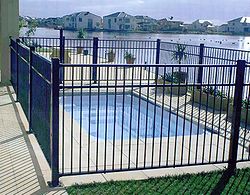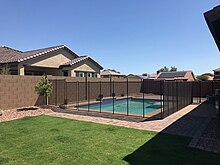Pool fence
This article needs additional citations for verification. (January 2012) |

A swimming pool fence is a type of fence placed around swimming pools, to create a passive barrier to restrict the access of small children, 0–5 years to the swimming pool. Swimming pool fences must have a self-closing and self-latching gate/s to be compliant to most countries' laws and codes.
Swimming pool fences are designed so that young children cannot climb over them or go through them. They are manufactured to strict standards to be sturdy, durable and non-climbable.
Most countries design, manufacture and install swimming pool fences to the International Code Councils (ICC) guidelines.
Main Types of Swimming Pool Fencing

Swimming pool fences are manufactured in several different types, using a variety of materials.
- Aluminum
- Steel
- Glass
- Vinyl/PVC Fencing
- Mesh
They can be slotted to allow visibility or solid for privacy.
Swimming Pool Barrier Compliance
Countries, states and municipalities within countries have different laws regarding swimming pool fencing laws, ranging from no laws at all to very strict laws and inspection programmes.
Australia
All swimming pools must comply with Australian Standard for Swimming Pool Fencing (AS1926-1986, AS1926.1-2007, and AS1926.1-2012). AS1926-1986 is for pools constructed before 30 August 2008. AS1926.1-2007 is for pools constructed between 1 September 2008 and 30 April 2013. AS1926.1-2012 is for pools constructed after 1 May 2013.[1] The standards were set forth by the Standards Australia Committee. The intent, as stated in AS1926.1-2007, Preface, was to "avoid pool-related drowning by providing design, construction and performance of various barrier options, which are designed to deny, delay or detect unsupervised entry to the swimming pool area by young children."
AS1926 calls for pool fencing that is 1200mm high, with a gap of 100mm or less at the bottom or between the panels. There should be no climbable objects within 900mm of the pool fencing, and gates should be built so that they swing away from the pool, with a child safety lock. The gate should be fitted with hinges that are self closing, and are able to do so from a stationary position without any manual force applied. Once closed, the gate should automatically lock and should not be able to be opened again with force unless the latch is manually opened. The gap between the gate panel and the latching panel should be less than 10mm.[2]
Some states and territories have laws and regulation of their own. Pool owners in states and territories with their own regulations must comply with both AS1926 and the local laws.
Queensland
The Queensland state of Australia has very strict laws by world standards. On 1 December 2010 legislation was implemented that will see all swimming pool barriers in the state inspected and issued with a compliance certificate by 30 November 2015.
Swimming pools be surrounded by a four-sided compliant barrier (using the home as one side of the barrier was outlawed) with a minimum height of 1200 mm (48 inches) from permanent ground level and have non-climbable zones of 900 mm (36 inches) in a 180 degree arc measured from the top of the barrier. For non-climbable zones to be compliant there must not be any objects that are more that 10 mm (0.5 inch) in depth and width in the non-climbable zone. Gates are to be self-closing, self latching and not able to be sprung open when a 25 kg (55 pound) downward force is applied to the bottom of the gate.[3]
All swimming pools in Queensland are required to be registered with the Pool Safety Council. Failure to do so would result in a fine.[4] All properties leased or sold must have a swimming pool compliance certificate.[5] Short term accommodation providers and shared swimming pools must be inspected every two years. Licensed private swimming pool inspectors inspect swimming pool barriers and issue pool safety compliance certificates.
New South Wales
New South Wales is the only Australian state or territory to require that infinity or drop edge pools have fencing greater than the standard 1200mm height requirement. Changes to the NSW legislation state that from 29 April 2016, NSW residential properties with a swimming pool or spa pool must have a certificate of compliance, a certificate of non-compliance or an occupation certificate for the pool barrier/fencing before the property can be leased or sold. [6]
United States
There is no federal pool fence law currently in place within the United States. However, several states, including Florida,[7] and Arizona,[8] have created their own individual pool fence laws. In 2017, the National Safety Council released a report ranking state laws on public pool and water facility regulations as well as 4-sided residential pool fencing.[9]
The Association of Pool & Spa Professionals has developed a model barrier code for residential swimming pools, spas, and hot tubs; this code has been approved by the American National Standards Institute.
The International Code Council (I.C.C.), more often known by their former name, the Building Officials and Code Administrators (B.O.C.A.), outlined strong safety standards for swimming pool fences. In an effort to eliminate or reduce the accidental drowning of children, these standards have been recognized by many communities throughout the world. Certain states are more strict with their laws and the most populated states with Pools such as Arizona, California, Florida, and Texas have special statutes in place that discuss all pool fencing types including frameless glass railings. Above ground pools must also follow state and local pool codes if the water is at least 18 inches deep.
The I.C.C. pool safety standards specify that:[10]
- The fence must be a minimum of 48" tall (or taller, depending on distance between horizontal rails).
- The middle horizontal rail must be at least 45" above the bottom horizontal rail (to prevent using the horizontal rails as a kind of ladder for climbing).
- The spacing between pickets must be less than 4".
- If space between pickets is less than 1 3/4'', rule #2 does not apply and fence does not have to be taller than 48'' (because the tighter picket spacing has made climbing much more difficult).
- The space between the bottom horizontal rail and the ground must be less than 2".
- The gate(s) must be self-closing and self-latching.
- The gate(s) need to open out (away from the pool area).
- The opening mechanism of the latch must be at least 54" above grade (ground level).
European Countries
European Countries
France was the first European country to introduce swimming pool barrier compliance regulations. The law was called "Raffarin Law." The effective date was 1 May 2004 for rental properties and 1 January 2006 for private properties. Failure to comply with this regulation can result in a €45,000 fine and criminal charges, if death by negligence occurred. The French law requires one of the following: fencing, a PVC pool cover, a glass cover, or an alarm.[11]
Spanish pool fence laws are for pools where the pool services 20 or more units. The law sets rules for children's pools, pool ladders, deck characteristics, life buoys, first aid kits, lifeguards, toilets, showers, maintenance books, fencing, and signage.[12]
Other Countries
Canada, The United Kingdom, New Zealand and South Africa also have swimming pool fencing laws.[citation needed]
See also
References
- ^ Nomanni, Miriam. "New South Wales (Australia) Pool Fencing Law – A Guide". NPF. Retrieved 5 September 2019.
- ^ "Does your pool comply?". Queensland Building and Construction Commission. Retrieved 5 September 2019.
- ^ Department of Housing and Public Works. "Pool fences and safety barriers". Retrieved 2018-04-29.
- ^ "Registering your pool". Retrieved 5 September 2019.
All residential pools in Queensland must be registered with the QBCC. Failure to do so could result in a fine.
- ^ Department of Housing and Public Works. "Pool safety". Retrieved 2018-04-29.
- ^ NSW Fair Trading. "Swimming Pools".
- ^ Statutes & Constitution :View Statutes : Online Sunshine
- ^ 36-1681 - Pool enclosures; requirements; exceptions; enforcement
- ^ National Safety Council (2017). The State of Safety - A State-by-State Report. Itasca, IL. p. 26. accessed at: http://www.nsc.org/NSCDocuments_Advocacy/State-of-Safety/State-Report.pdf
- ^ https://codes.iccsafe.org/content/ISPSC2015/chapter-3-general-compliance?site_type=public
- ^ Larner, Judith. "France sounds the alarm on safety". theguardian.com. The Guardian. Retrieved 5 September 2019.
- ^ "Spanish Swimming Pool Law: Communal Pools". angloinfo.com. AngloInfo. Retrieved 5 September 2019.
